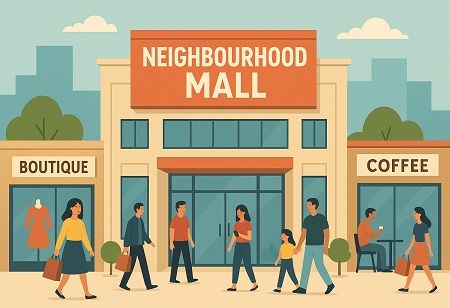
For years, Indian retail was measured in size; the bigger the mall, the bigger the bragging rights. But walk through Delhi-NCR today and you’ll notice something changing. Compact neighbourhood malls are emerging in areas such as Noida Extension, Dwarka, and Gurugram’s new sectors and high-density areas, designed to seamlessly integrate into daily life.
The idea is simple. People no longer want to drive an hour, hunt for parking, and spend half a day in a mall just to pick up groceries and catch a film. Post-pandemic habits have reinforced this. Shoppers prefer retail spaces near residential areas that sits closer to home, within a 10–15-minute drive.
Knight Frank’s latest study highlights that dense micro-markets are now the primary drivers of retail growth in NCR. These malls usually range between 50,000 and 200,000 sq ft with a high-quality supermarket at the centre, surrounded by a few F&B brands, salons, wellness clinics, a play zone or a small multiplex, plus essential services like banks and pharmacies. It’s enough to keep footfalls steady throughout the week. CBRE data shows retail leasing in India shot up nearly 50 percent in 2023, and a significant chunk was driven by new malls of this scale. According to a recent report by Cushman & Wakefield, retail leasing in high streets across Delhi-NCR jumped a massive 57 percent year-on-year in Q1 2025, accounting for 61 percent of the region’s total leasing activity. Gurugram led the way, followed by Noida and Delhi. Much of it was driven by neighbourhood malls.
Also Read: How Sarjapur Road-Gunjur's Proximity to IT Hubs is Transforming Real Estate Investments
Pankaj Jain, Founder and CMD, SPJ Group, says, “Neighbourhood malls are redefining the urban retail experience by combining convenience with community. He notes that design and layout play an integral role in a retail project's success: "Developers are realising that the format must look and feel different from the boxy malls of the 2000s. Curated is the keyword. People don’t want 200 stores. They want a clean, walkable space where the mix of tenants feels right. With evolving lifestyles and a growing preference for hyperlocal experiences, we are seeing increasing fondness for these formats as they deliver both footfall consistency and a sense of belonging for residents. For developers, this is not just about building retail spaces, but about creating vibrant social hubs that enhance liveability. In our project design, we are particular in designing them for everyday use, but with enough character to become the go-to social spot. That’s how you build loyalty."
Arjun Gehlot, Director, Ambience Malls says "The ability to tailor tenant mix is another edge. As cities like Gurugram continue to evolve, malls here are shaping up as cultural and community centers that define urban living. The city’s purchasing power now rivals that of Delhi, which makes it an attractive destination for both consumers and brands. This has created a natural pull for top international retailers who now see Indian malls as the most strategic entry point to connect with an aspirational and diverse consumer base. Global fashion and lifestyle names coexisting alongside national brands and even familiar neighbourhood favourites offer a holistic experience that feels both world-class and rooted in community.”
Ajendra Singh, VP, Sales and Marketing, Spectrum@Metro, says, "For developers, the case is practical as much as it is strategic. Smaller malls don’t tie up capital for years, and leasing cycles are quicker. More importantly, they tap into a ready-made catchment of residents. Post-pandemic behaviour has made this model stronger. People want F&B and essential retail right next door. For us, it creates value on both sides, our housing projects get a retail anchor for townships, while the mall itself finds tenants faster and delivers steady yields.”
Across India, from Bengaluru’s Whitefield to Mumbai’s suburbs, similar stories are playing out. But NCR’s density and township-led growth may make it the testing ground for the model. Analysts point out that as the region sprawls further outward, compact retail will be the backbone of urban retail in these self-contained ecosystems.
So while the big malls will always have their place on the weekends, it’s the compact neighbourhood centre that is fast becoming the workhorse of urban retail. In NCR, especially, that shift is visible every time a new township opens, and almost immediately, a neighbourhood mall rises to complete it.6
We use cookies to ensure you get the best experience on our website. Read more...
Copyright © 2025 HomesIndiaMagazine. All Rights Reserved.